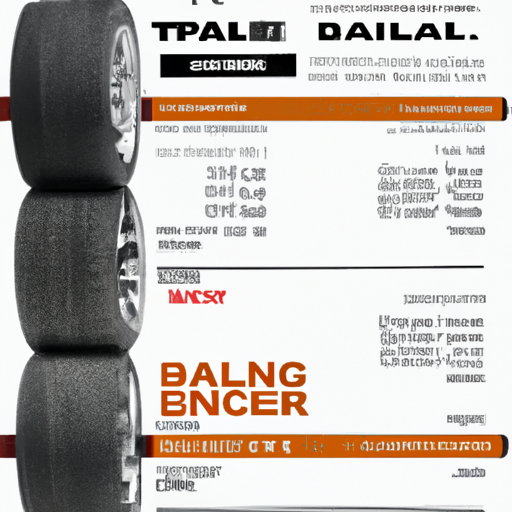Have you ever wondered how to tell if your tires need balancing? Uneven wear, vibrations, and steering wheel vibrations are just a few indicators that it may be time to have your tires balanced. In this article, we will explore the signs that your tires need balancing and why it’s important to maintain proper tire balance for a smooth and safe driving experience. So, if you’ve been wondering about the subtle signs of tire balancing issues, keep reading to find out more!
Signs of Imbalanced Tires
Vibration at high speeds
One of the most common signs that your tires might be imbalanced is experiencing vibrations at high speeds. If you notice that your car shakes or vibrates when you reach a certain speed, it could be an indication that your tires are out of balance. These vibrations can sometimes be felt in the steering wheel or even throughout the entire vehicle. It’s important not to ignore this symptom, as it can not only affect the comfort of your ride but also potentially lead to more serious issues with your tires and other components of your vehicle.
Uneven tire wear
Another telltale sign of imbalanced tires is uneven tire wear. When your tires are not properly balanced, they can wear unevenly, causing certain areas of the tires to wear down more quickly than others. You may notice that the tread on one side of the tire is lower than the other, or that there are patches of excessive wear. Uneven tire wear not only compromises the performance and handling of your vehicle but can also lead to a shorter lifespan for your tires. Regularly inspecting your tires for signs of uneven wear is essential in maintaining a safe and smooth driving experience.
Steering wheel vibrations
If you feel vibrations through the steering wheel, particularly when you’re driving at lower speeds, it could be an indication of tire imbalance. When the tires are imbalanced, the imbalance can cause the steering wheel to vibrate or shake, making it more difficult to maintain proper control of your vehicle. This can be not only an annoyance but also a safety concern, as it can potentially affect your ability to steer and maneuver your car effectively. If you notice vibrations in your steering wheel, it’s a good idea to have your tires checked for balance as soon as possible.
Pulling to one side
Imbalanced tires can also cause your vehicle to pull to one side or the other while driving. This pulling sensation occurs when one or more of your tires are significantly unbalanced, causing uneven pressure on the wheels. As a result, your vehicle may drift or veer to one side, even when you’re trying to drive in a straight line. Not only can this be frustrating, but it can also be dangerous, especially if you’re driving at high speeds or on wet or slippery road conditions. If you notice your car pulling to one side, it’s important to have your tires balanced to ensure your vehicle’s stability and safety.
Cupping on tires
Cupping, also known as scalloping, is a common tire wear pattern that can occur when your tires are imbalanced. It appears as small, cup-shaped indentations on the surface of the tire tread. Cupping is often a result of uneven weight distribution on the tire, which can be caused by tire imbalance. This type of tire wear not only affects the performance and handling of your vehicle but can also lead to increased road noise and a less comfortable ride. If you notice cupping on your tires, it’s crucial to have them balanced and inspected to prevent further damage and ensure optimal tire performance.
Excessive noise
Imbalanced tires can contribute to excessive noise while driving. If you notice an increase in road noise or a humming sound coming from your tires, it could be a sign that your tires are out of balance. When tires are imbalanced, they can cause vibrations that result in increased noise levels. This noise can range from a low rumble to a high-pitched whine, depending on the severity of the imbalance. If you’re experiencing excessive tire noise, it’s advisable to have your tires balanced to restore a quieter and more comfortable driving experience.
Causes of Tire Imbalance
Uneven tread wear
Uneven tread wear is one of the primary causes of tire imbalance. When the tread on your tires wears down unevenly, it can lead to an imbalance in weight distribution. This can occur due to various reasons, such as improper tire inflation, misalignment, or suspension issues. It’s crucial to regularly inspect your tires for signs of uneven tread wear and address any potential issues promptly to prevent tire imbalance and extend the lifespan of your tires.
Bent rims
Having bent or damaged rims can significantly impact the balance of your tires. If your rims are bent, even slightly, it can cause uneven weight distribution and result in tire imbalance. Bent rims can occur from hitting potholes, curbs, or other road hazards. It’s important to have your rims inspected and replaced if necessary to ensure proper tire balance and avoid further damage to your tires and vehicle.
Misalignment
Misalignment occurs when the angles of your wheels are not correctly aligned with each other or with the vehicle’s specifications. This can lead to uneven tire wear and imbalance. Misalignment can be caused by various factors, including hitting potholes, curbs, or other objects on the road. Regular wheel alignments are essential in maintaining proper tire balance and minimizing the risk of tire imbalance and associated issues.
Improper tire installation
Another common cause of tire imbalance is improper tire installation. When tires are not mounted correctly onto the rims or if the tread is not aligned properly with the wheel, it can result in imbalance. It’s crucial to have your tires installed by a professional who has the knowledge and expertise to ensure a proper and balanced fit. If you suspect that your tire installation was not done correctly, it’s important to have it checked and corrected as soon as possible to avoid potential safety hazards.
Worn suspension components
Worn suspension components, such as shocks or struts, can also contribute to tire imbalance. When the suspension system is not functioning correctly, it can affect the overall stability and balance of your tires. Worn suspension components can result from normal wear and tear or harsh driving conditions. It’s advisable to have your suspension system inspected regularly and replace any worn components to maintain proper tire balance and ensure a smooth and safe driving experience.

When to Balance Your Tires
New tire installation
When you have new tires installed on your vehicle, it’s essential to have them balanced. Even brand new tires can have slight imbalances due to manufacturing processes. Balancing your tires when they’re new helps ensure optimal performance, longevity, and a smoother ride.
Tire rotation
Regular tire rotations are crucial in maintaining even tire wear and extending the lifespan of your tires. During a tire rotation, it’s a good idea to have your tires balanced as well. This helps distribute any imbalance that may have occurred during normal driving and promotes even tire wear on all four wheels.
Road force balance
Road force balance is a specialized type of tire balancing that takes into account the force exerted on the tires while driving. This method provides a more accurate and precise balance for your tires. If you notice any signs of tire imbalance, such as vibrations or uneven wear, it’s advisable to consider a road force balance to address the issue effectively.
Vibration while driving
If you experience vibrations while driving, particularly at higher speeds, it’s important to have your tires balanced. Vibrations can be a clear indication of tire imbalance and should not be ignored. Balancing your tires in response to vibrations helps restore a smooth and comfortable ride, as well as prevent further damage to your tires and other vehicle components.
After hitting a pothole or curb
Hitting a pothole or curb can lead to tire damage and potential imbalance. If you’ve recently encountered such an impact, it’s a good idea to have your tires checked for balance to address any potential issues caused by the impact. Prompt action can prevent further damage and ensure your tires are in optimal condition.
Tire Balancing Process
Inspecting the tires
The first step in the tire balancing process is inspecting the tires. A professional will examine the tires for any visible signs of damage, such as bulges, cuts, or excessive wear. They will also check for any foreign objects, like nails or screws, that may have punctured the tire. Inspecting the tires helps ensure their overall condition and identify any issues that may affect the balancing process.
Mounting the tires
Once the tires have been inspected and deemed suitable for balancing, they are mounted onto a specialized machine. This machine securely holds the tire in place while allowing for precise measurement and adjustment. It’s crucial to mount the tires correctly to ensure an accurate balancing process.
Checking the wheel balance
After the tires are mounted, the machine will spin them at high speeds. The machine uses sensors to measure the balance of the tire and detect any imbalances. This process helps identify whether any weights need to be added or removed to achieve optimal balance.
Adding weights
If the machine detects any imbalances, small weights are added to the rim of the tire. These weights counteract the imbalance and promote a smooth and even rotation of the tire. The weights used are specifically designed for balancing purposes and are carefully placed in the appropriate locations to achieve the desired balance.
Rechecking the balance
Once the weights are added, the machine will spin the tire again to ensure that the balance has been achieved. If the tire is still imbalanced, further adjustments will be made until the desired balance is attained. Rechecking the balance ensures that the tire is correctly balanced and ready for optimal performance on the road.

DIY Tire Balancing
Using a bubble balancer
A bubble balancer is a basic tool that can be used for DIY tire balancing. It consists of a metal rod with a bubble level attached to it. To use a bubble balancer, you place the wheel and tire assembly onto the balancer and observe the bubble level. You then adjust the position of the tire on the balancer until the bubble is centered, indicating that the tire is balanced. This method can provide a rough estimate of tire balance but may not be as accurate as professional balancing equipment.
Using a dynamic balancer
A dynamic balancer is a more advanced tool that provides a more accurate and precise tire balance. It is typically used by professionals but can also be rented or purchased for DIY use. A dynamic balancer works by spinning the tire and measuring any imbalances. It then provides guidance on where to add weights to achieve the desired balance. Using a dynamic balancer can yield more precise results compared to a bubble balancer.
Necessary tools and equipment
If you decide to attempt DIY tire balancing, there are a few essential tools and equipment you will need. These include a bubble balancer or dynamic balancer, wheel weights, and a lug wrench to remove and reinstall the wheels. It’s important to note that DIY tire balancing may not provide the same level of accuracy and precision as professional balancing. If you’re unsure about the process or have any doubts, it’s always best to seek the assistance of a professional tire shop.
Professional Tire Balancing
Choosing a reputable tire shop
When it comes to professional tire balancing, it’s essential to choose a reputable tire shop. Look for shops with positive reviews, a good track record, and experienced technicians. Personal recommendations from friends, family, or trusted mechanics can also be helpful in finding a reliable tire shop. A reputable tire shop will have the necessary equipment, expertise, and commitment to providing quality service.
Checking for certifications
Certifications can be an indication of a tire shop’s professionalism and expertise. Look for certifications such as those from the Automotive Service Excellence (ASE) or the Tire Industry Association (TIA). These certifications show that the technicians have undergone training and meet certain industry standards. Choosing a tire shop with certified technicians can give you peace of mind knowing that your tires will be balanced correctly.
Cost of professional tire balancing
The cost of professional tire balancing can vary depending on various factors, such as the location, the tire shop, and the type of balancing method used. Generally, the cost ranges from around $20 to $100 per tire. It’s important to consider the value and benefits of professional balancing, such as increased safety, improved performance, and extended tire lifespan. Ultimately, the cost of professional tire balancing is a worthwhile investment in maintaining the overall health and longevity of your tires.

Frequently Asked Questions
How often should I balance my tires?
Tire balancing is generally recommended every 5,000 to 6,000 miles or whenever you have your tires rotated. However, it’s important to note that this can vary depending on various factors, such as driving conditions, vehicle type, and tire wear patterns. It’s a good idea to consult your vehicle’s owner’s manual or your tire manufacturer’s recommendations for specific guidance on how often to balance your tires.
Can unbalanced tires cause damage?
Yes, unbalanced tires can cause damage to your vehicle and negatively impact its performance. Imbalanced tires can lead to uneven tire wear, which can result in the need for premature tire replacement. They can also put additional stress on other vehicle components, such as the suspension, steering, and wheel bearings. Furthermore, driving with imbalanced tires can compromise your safety and make it more challenging to control your vehicle properly.
Can I drive with imbalanced tires?
While it’s technically possible to drive with imbalanced tires, it’s not advisable. Imbalanced tires can affect your vehicle’s performance, safety, and overall driving experience. When your tires are imbalanced, it can result in vibrations, uneven tire wear, pulling to one side, and reduced handling. It’s important to address any tire imbalance issues promptly to ensure optimal tire performance and safety on the road.

